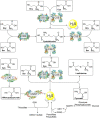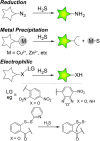Advances and Opportunities in H2S Measurement in Chemical Biology
- PMID: 37885594
- PMCID: PMC10598833
- DOI: 10.1021/jacsau.3c00427
Advances and Opportunities in H2S Measurement in Chemical Biology
Abstract
Hydrogen sulfide (H2S) is an important biological mediator across all kingdoms of life and plays intertwined roles in various disciplines, ranging from geochemical cycles to industrial processes. A common need across these broad disciplines is the ability to detect and measure H2S in complex sample environments. This Perspective focuses on key advances and opportunities for H2S detection and quantification that are relevant to chemical biology. Specifically, we focus on methods for H2S detection and quantification most commonly used in biological samples, including activity-based H2S probes, the methylene blue assay, the monobromobimane assay, and H2S-sensitive electrode measurements. Our goal is to help simplify what at first may seem to be an overwhelming array of detection and measurement choices, to articulate the strengths and limitations of individual techniques, and to highlight key unmet needs and opportunities in the field.
© 2023 The Authors. Published by American Chemical Society.
Conflict of interest statement
The authors declare no competing financial interest.
Figures









References
-
- Marriott R. A.; Pirzadeh P.; Marrugo-Hernandez J. J.; Raval S. Hydrogen sulfide formation in oil and gas. Can. J. Chem. 2016, 94 (4), 406–413. 10.1139/cjc-2015-0425. - DOI
-
- Reece G. M. W. B.; Drinker P. Determination and Recording of Carbon Disulfide and Hydrogen Sulfide in the Viscose-Rayon Industry. J. Indust. Hygiene Toxicol. 1940, 22 (9), 416–424.
-
- Pandey S. K.; Kim K.-H.; Tang K. A review of sensor-based methods for monitoring hydrogen sulfide. Trends. Analyt. Chem. 2012, 32, 87–99. 10.1016/j.trac.2011.08.008. - DOI
Publication types
Grants and funding
LinkOut - more resources
Full Text Sources
